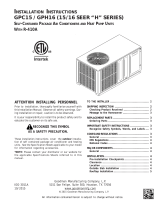
11
continuously. Check for air delivery at the
register(s).Ensurethattherearenoobstructions
attheregistersorintheductwork.Setthermostat
fan switch to “Auto.”
System Cooling
1. Setthethermostatsystemswitchto“Cool”
and the thermostat fan switch to “Auto”.
Graduallylowerthethermostattemperature
switch below room temperature and observe
thattheblower,compressor,andfanenergize.
Checkthataircoolerthanroomtemperature
isbeingdischargedattheregister.Listenfor
any unusual noises.
2. After allowing the unit to run for several
minutes,setthetemperatureselectorabove
room temperature. The fan and compressor
cycles off with the thermostat. The blower
should also stop unless fan switch is set to
“ON”position.
System Heating — Set the system thermostat
switchtoHEATandsetthethermostatfanswitch
toAUTO.Verifythatthecompressor,outdoorfan,
andblowerareenergized.Checkforwarmair
at the supply registers.
DEFROST CONTROL BOARD OPERATION
AND TESTING
1. Terminals “R”-”C” must have 24±V present
between them in order for the time delay and
defrost sequences to be operational.
2. Jumper the “T2”-”DFT” test pins. This will
indicate to the board that the defrost T-stat
is closed(if the compressor is running).
DefrostT-statisclosedat32°orbelowand
is open at 68° or above. But it’s state is
unknownifthetemperatureisbetween32°F
and68°F.Thedefrostthermostattellsthe
board whether a defrost cycle needs to be
startedorterminated.WiththeDFTclosed
the unit will run for 30/60/90 minutes in heat
mode and then defrost the outdoor coil. The
defrostwillturnofftheoutdoorfan,turnonthe
compressor and raise the coil temperature to
68°F.ThiswillopentheDFTandterminate
thedefrost.IftheDFTdoesnotopenthe
defrost will end after 10 minutes.
3. Defrostboardspeed-up.Withcompressor
runninginheatmode,nextjumpthe“Test”
pinto“C”onterminalstrip.Thiswillinitiate
adefrosttestin5,10or15seconds(This
is determined by the 30, 60 or 90 minute
defrost pin settings. The factory setting will
be30minutes).Notethatthiswillbypassthe
compressor off delay when the unit goes into
defrosttestandifleftindefrosttest,thedelay
will be bypassed when the test is terminated
by the processor. If the jumper is removed
before the test is over the processor will
perform the remainder of a normal defrost.
See step 2 above.
4. Remove the jumpers.
Note: The delay/no-delay pin concerns
compressor operation during defrosts. The default
setting is delay. Reciprocating compressors
should only use this setting in conjunction with
anapprovedhardstartkit.Scrollcompressors
that have noise issues while going into or coming
out of defrost should use this 30 second delay to
reduce the defrost noise. To switch from no-delay
to delay remove the pin from the “no-delay” pin
location and shift it to the “delay” pin location.
Speed up changes:
Manuallyinitiatinga defrostwillcause the
compressor to run continually when entering
defrost.
Normal defrost operation:
To test normal defrost operation when the
temperature is above 35°F, jumper “R” to
“DFT”onthe624656boardandallowtheunit
torunfor30minutes.Defrostwillcontinue
untilthe“R”to“DFT”jumperisremovedor
for 10 minutes. Remove the jumper.
The 5 minute time delay feature can be shortened
1timeto1secondbyjumpingthe“Test”to“C”
terminal. Remove the jumper and repeat as
desired.
Note: If jumper is left on the “Test” to “common”
pinspermanently,thedefrostcyclewillbecome
inoperable.
Defrost Test Procedure for 624656
1. Jumper“T2”to“DFT”atthetestterminals.
2. With unit running in heatmode, short the
“TEST”terminaltothecommonterminalnear
it. This will speed up the board and cause
it to enter defrost mode in 5/10/15 seconds
depending on the defrost time selection.
Compressor delay will not function during
speed-up.
3. Thistestwillendin5secondsifthe“TEST”-
common short is not removed.
4. Removeboththeshortandthe“T2”to“DFT”
jumper to terminate the defrost cycle. The
30 second compressor delay should operate
normally.
5. Testiscomplete,resetthermostattohome
owner preference.




















